Discover 11 hidden attractions, cool sights, and unusual things to do in Paphos (Cyprus). Don't miss out on these must-see attractions: Tombs of the Kings, Paphos Archaeological Park, and Saranta Kolones. Also, be sure to include Basilica of Panagia Limeniotissa in your itinerary.
Below, you can find the list of the most amazing places you should visit in Paphos (Paphos).
Table of Contents
Tombs of the Kings
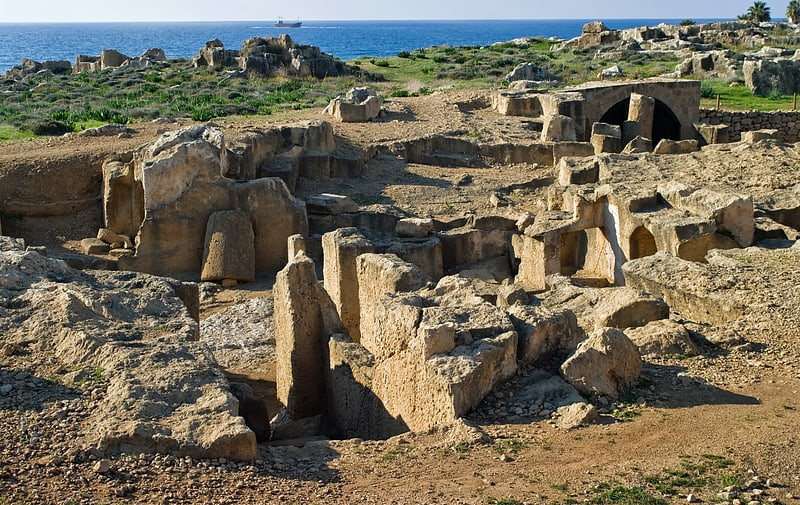
Large, ancient necropolis with tombs. The Tombs of the Kings is a large necropolis lying about two kilometres north of Paphos harbour in Cyprus. In 1980, it was designated a UNESCO World Heritage Site along with Paphos and Kouklia.
The underground tombs, many of which date back to the 4th century BC, are carved out of solid rock, and are thought to have been the burial sites of Paphitic aristocrats and high officials up to the third century AD (the name comes from the magnificence of the tombs; no kings were in fact buried here). Some of the tombs feature Doric columns and frescoed walls. Archaeological excavations are still being carried out at the site. The tombs are cut into the native rock, and at times imitated the houses of the living.
The tombs have been known and casually explored for centuries. The oldest modern account was written by Richard Pockocke, in 1783. Almost a century later, in 1870 the first archaeological excavations were conducted by Luigi Palma di Cesnola, the Italian-born American consul to Cyprus. In 1915 the first excavations under scientific supervision took place, led by Menelaos Markides, who was the curator of the Cyprus Museum. Systematic excavations took place in the late 1970s and the 1980s under the direction of Dr Sophocles Hadjisavvas, former Director of Antiquities of the Republic of Cyprus.
Dr Hadjisavvas is preparating the finds for publication with assistance from the Australian archaeological mission to Paphos.
Part of the importance of the tombs lies in the Paphian habit of including Rhodian amphorae among the offerings in a burial. Through the manufacturing stamps placed on the handles of these amphorae, it is possible to give them a date and, through them, the other material from the same burial.
Thus, it is hoped to develop a more secure chronology for archaeological material in the Eastern Mediterranean of the Hellenistic and early Roman periods.
It is reported that much of the information related to the tombs was lost over time. Several factors contributed to that: It is believed that many of the tombs were rich in expensive grave goods, despite that very few of such goods were to found by the official archaeological missions, and thus it is believed that grave robbers of the past were responsible. Also, the tombs’ proximity to the sea side hindered the preservation of the buried bodies. Despite those obstacles, the historical significance of the Tombs is well established among experts and locals.[1]
Address: Tombs of the Kings Ave, 8840 Πάφος
Paphos Archaeological Park
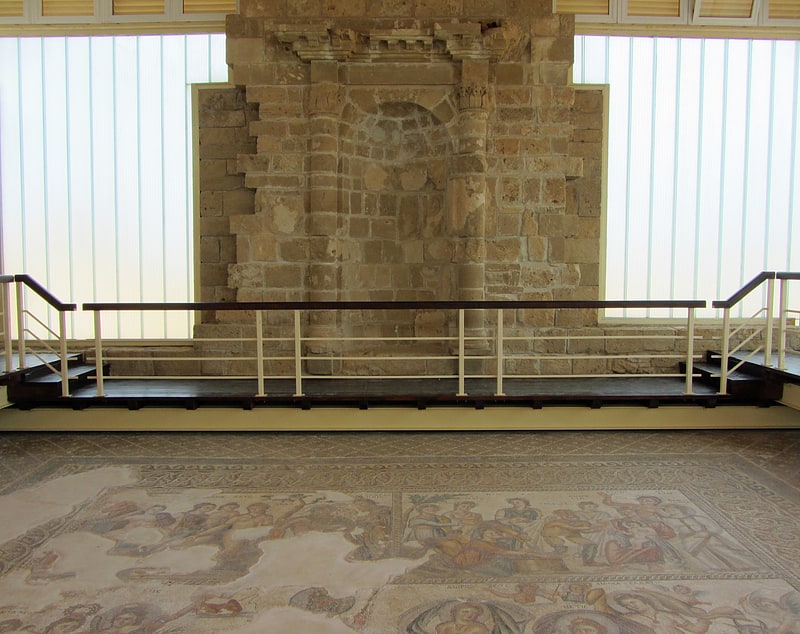
Archaeological site in Paphos, Cyprus. Paphos Archaeological Park contains the major part of the important ancient Greek and Roman city and is located in Paphos, southwest Cyprus. The park, still under excavation, is within the Nea Pafos section of the coastal city.
Its sites and monuments date from prehistoric times through the Middle Ages. Among the most significant remains so far discovered are four large and elaborate Roman villas: the House of Dionysos, the House of Aion, the House of Theseus and the House of Orpheus, all with superb preserved mosaic floors, especially an Orpheus mosaic. In addition, excavations have uncovered an agora, asklipieion, basilica, odeion, and Hellenistic-Roman theatre, and a necropolis known as the "Tombs of the Kings".
Nea Paphos is one of the three components forming the Paphos archaeological complex inscribed on the UNESCO World Heritage List in 1980 for its outstanding mosaics and ancient remains, as well as its historical religious importance.[2]
Saranta Kolones
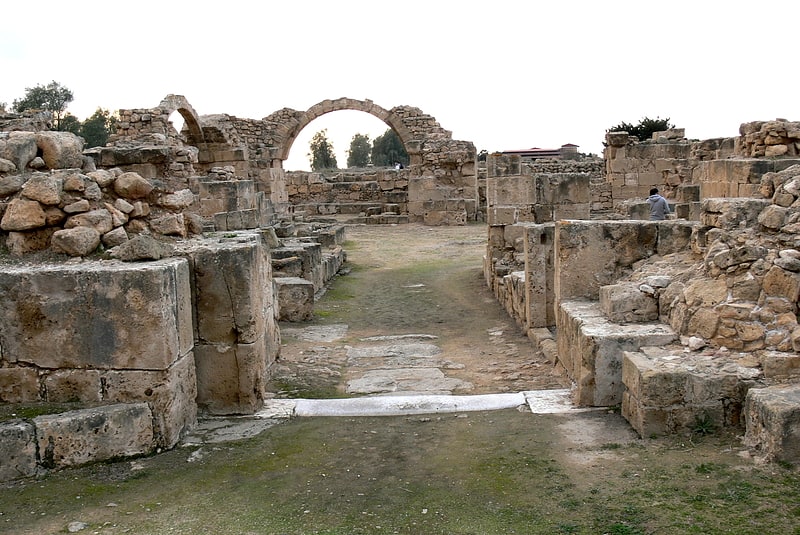
Historical landmark in Paphos, Cyprus. Saranta Kolones is a ruined medieval fortress inside the Paphos Archaeological Park and it is located just north of the harbour of Paphos, on the island of Cyprus. It takes its name from the large number of granite columns that were found on the site and probably once formed part of the ancient agora. The Byzantine castle is believed to have been built at the end of the 7th century AD to protect the port and the city of Nea Pafos from Arab raids and later remodeled by the Lusignans. The Fortress had a three-metre thick wall with four huge corner towers and another four intermediary towers along the joining walls and moat surrounding the castle. Access was across a wooden bridge spanning the moat. The square courtyard measured 35 metres long by 35 metres wide, with a tower at each corner. The main entrance was through a fifth, horseshoe-shaped tower on the east side. Destroyed by an earthquake in 1222, the castle was subsequently abandoned. In modern times a series of excavations have taken place.[3]
Basilica of Panagia Limeniotissa
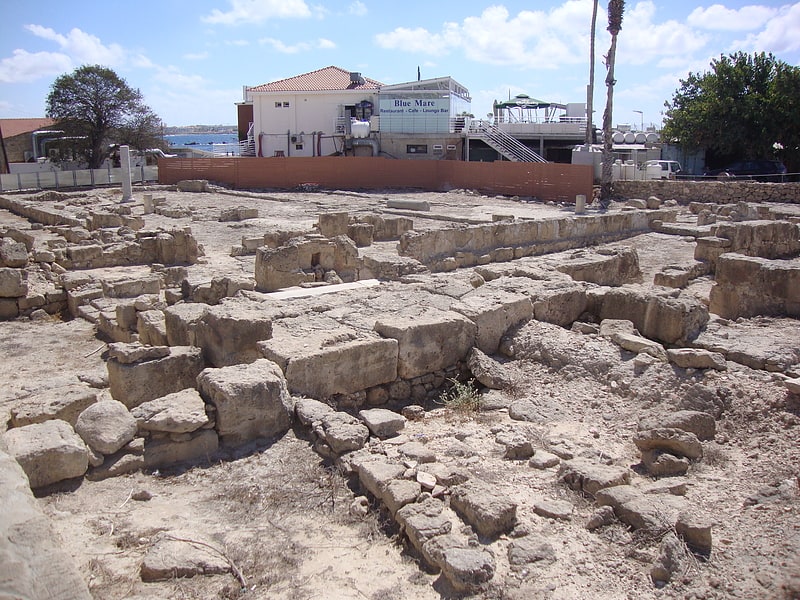
Historical landmark in Paphos, Cyprus. The Basilica of Panagia Limeniotissa is a ruined basilica in Paphos, Cyprus. It was built at the beginning of the 5th century and it is dedicated to "Our Lady of the Harbour".
The basilica of Panagia Limeniotissa is situated in a short distance north of Paphos harbour, close to the restaurants of the harbour and it is part of the Paphos Archaeological Park. Visitors can see some colourful mosaics and a few restored columns.[4]
Church of Panagia Theoskepasti
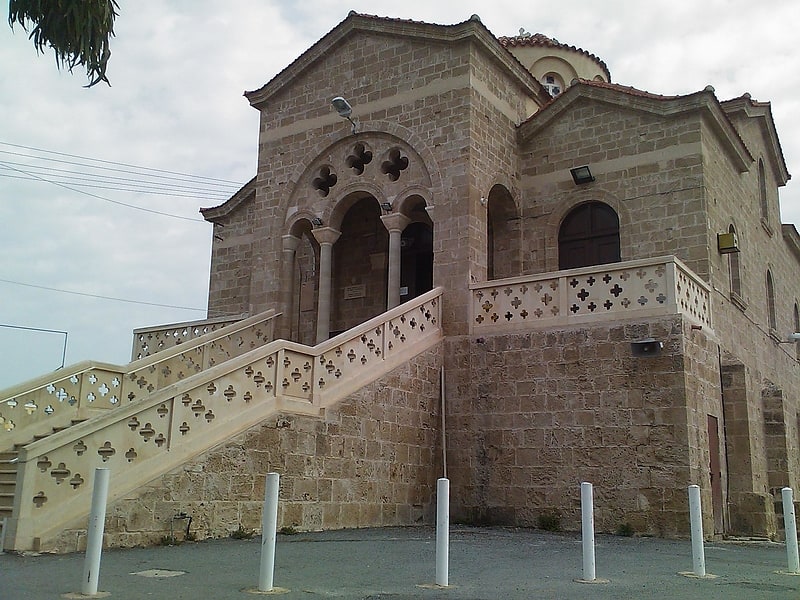
Church in Paphos, Cyprus. Panagia Theoskepasti is a Byzantine Church of Cyprus church at the center of Kato Paphos, Cyprus. It is part of an area inscribed in the list of the UNESCO World Heritage Sites in 1980.[5]
Address: Panagias Theoskepastis, Paphos
Paphos Archaeological Museum
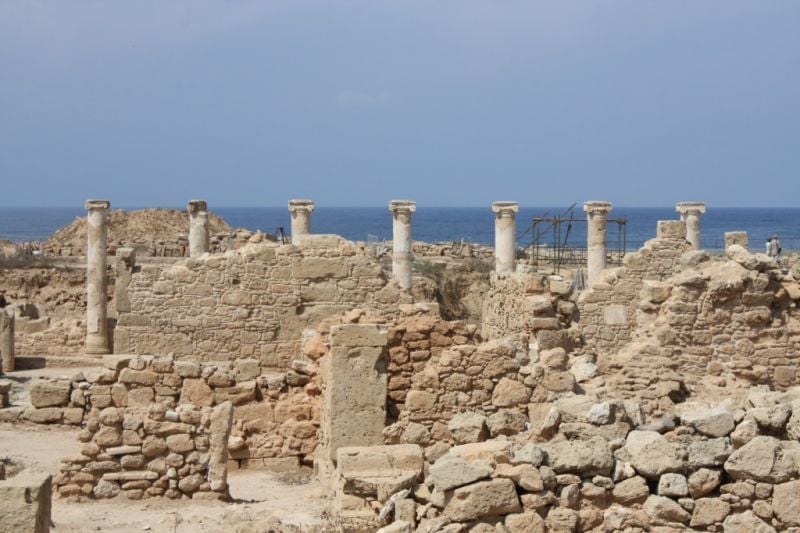
Museum in Paphos, Cyprus. Paphos Archaeological Museum is a museum in Paphos, western Cyprus. It contains items ranging in age from the Neolithic to 1700 AD, with five rooms showcasing exhibits dating from the Neolithic era to the Middle Ages. Most of the artefacts were unearthed in Palepafos, Nea Pafos and Marion-Arsinoe, and also from Pegeia, Kisonerga, Lempa, Pano Arodes, Salamiou, Akourdalia, Pomos, Kidasi, Geroskipou and other places. The collection includes skeletal remains recovered from 31 tombs near the eastern seafront of the ancient city of Nea Pafos in 1980–3.[6]
Address: Β6 43, Paphos
Hamam Cafe Lounge Bar
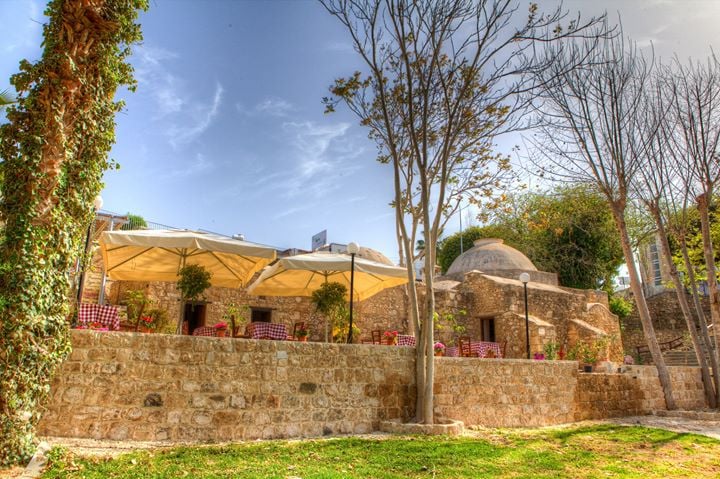
Bars and clubs, Cafe, Museum
Address: Turkish Baths, Paphos
Paphos Lighthouse
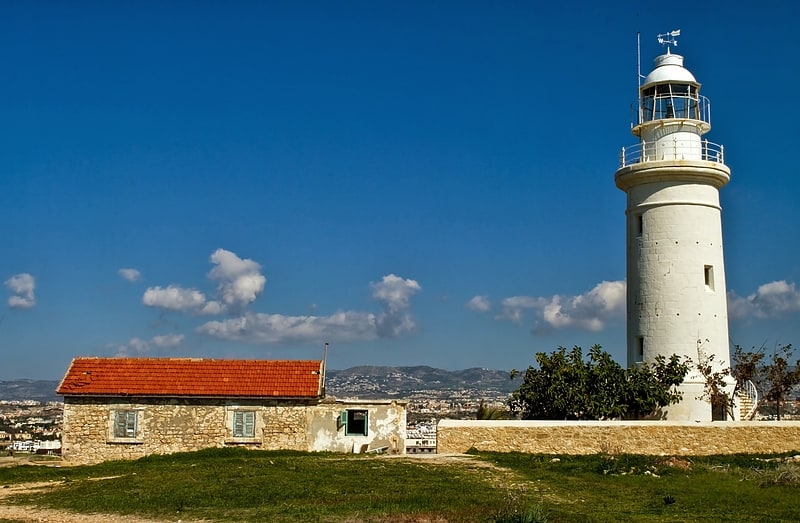
Paphos Lighthouse is a well known lighthouse on the island of Cyprus, near to the town of Paphos. It is sited on a peninsula known as Paphos point which extends into the Mediterranean Sea, at the south western end of the island.
Built in 1888, when Cyprus was under British administration, the island was a key military base protecting the route of ships travelling through the Suez Canal to the colonies. The light acted as a landfall marker for shipping destined for Paphos harbour from Britain.
The 20m high whitewashed masonry tower has a single gallery and lantern. Enclosing the tower is a compound containing the keeper's house and outbuildings.
With a focal height of 36m above the sea, its light can be seen for 17 nautical miles, and consists of a long flash of white light every fifteen seconds.[7]
Paphos Castle
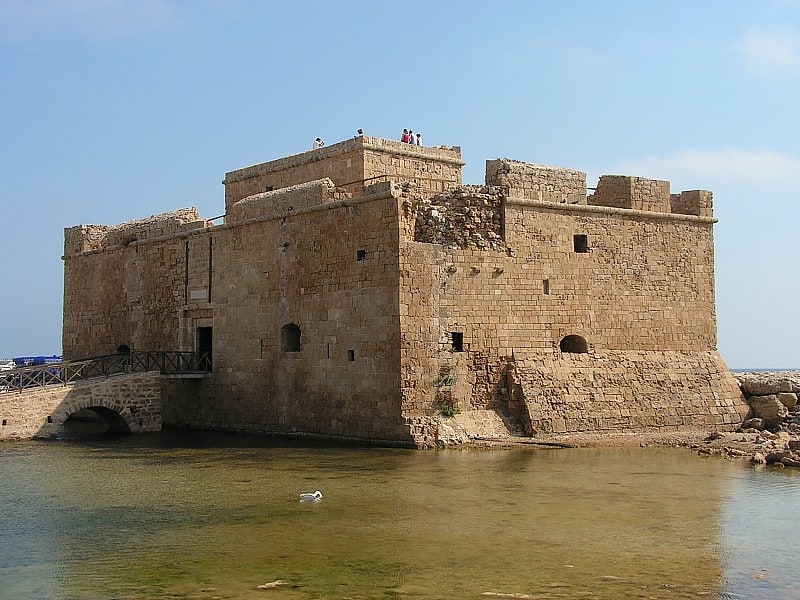
Also known as: Κάστρο της Πάφου
Historic castle with many past uses. Paphos Castle is located at the western end of the city port. It was originally a Byzantine fortress built to protect the port. Today, the visitor can see the Western Frankish Tower with the Venetian additions as restored by the Ottomans in 1592, according to a relevant inscription above the entrance of the castle. A white marble slab above the entrance of the tower refers to its reconstruction in 1592 AD, by the Turkish governor of Cyprus Ahmet Pasha.
The main fortress of the city was located in Saranta Kolones, about 600 meters west, and was destroyed by the earthquake of 1222.
The original Byzantine fortress was destroyed in the earthquake of 1222. It was rebuilt and expanded by the Lusignans in the 13th century. They also built the so-called "Genoese Towers". It is a castle consisting of a complex of 2 towers, the ruins of which are located 80 meters east of the Castle, right at the entrance of the port and served as the best defense. Although these towers were considered subservient to the larger castle they had no contact with each other and were probably a separate castle. They got their name because of their importance in the battle against the Genoese in 1373, where they played an important role in the defense of the city port, as the Genoese were mainly a naval force. They were also important in the battle against the Mamluks in 1426, where they suffered severe damage and have not been rebuilt since. The Towers were destroyed after a strong earthquake in 1491, but their ruins are still visible. The castle was maintained by the Venetians who made some additions.
The Castle resisted the Genoese invasion in 1373 and was one of the few not covered by the Mamluks in 1426, under the guidance of its Guardsman, Sforza, who was a fierce Spanish mercenary. In August 1570, when the Turks landed, his guard failed to leave it, as was the case in other cases. Despite the bravery of the defenders and the good position of the Castle after 16 days of fierce fighting, his guard resisted inside the Castle which was destroyed. The Ottomans repaired the ruins of the castle, based on the original building, as due to its strong construction there was no complete destruction. The castle during the Turkish occupation had a guard of 100 men and 12 cannons which left with the arrival of the British in 1878.
The main part of the castle consists of a large rectangular tower (dimensions: 40 × 20 m) with a closed courtyard in the middle. The ground floor consists of a central hall with small rooms and large rooms on each of its two large sides, which were used as prisons and barracks during the Ottoman rule. On the roof there is a small square Tower (dimensions: 15 × 10 m) with three large rooms, where the Guard of the Castle lived. At the same level around the perimeter there are 12 ramparts on the roof, which could hold a corresponding number of cannons during the Turkish occupation. In 1878, with the arrival of the British, the Castle ceased to be used for military purposes and became a salt depot until 1935, when it was declared an ancient monument under the Antiquities Act. Since then it represents one of the most characteristic landmarks of the city of Paphos. In 1938-9 various cracks in the walls and the breakwater were repaired. The castle was devastated by the earthquake of 1953 and repairs were completed in 1969. It was also hit by the Turkish air and naval forces during the bombing of the port of Paphos on July 21, 1974, but suffered no serious damage. Most recently, the castle serves as the setting for the annual Paphos Outdoor Cultural Festival in September. Several archeological excavations have been carried out to investigate its past.
Currently, the castle is used as a tourist attraction and occasionally has thematic exhibitions. Admission is € 2.50, visiting hours are 8: 30-17: 00 in winter and 8: 30-19: 30 during summer. The ground floor of the Castle is accessible for people using a wheelchair, but not the Upper floor.[8]
Byzantine Museum
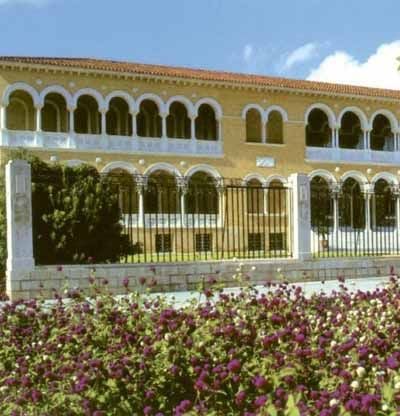
Museum
Atlantis Turtle Watching Cruise

Boat tours, Nature and wildlife tours, Scuba and snorkeling, Fishing charters and tours, Outdoor activities, Tours
Address: Paphos Harbor, Paphos